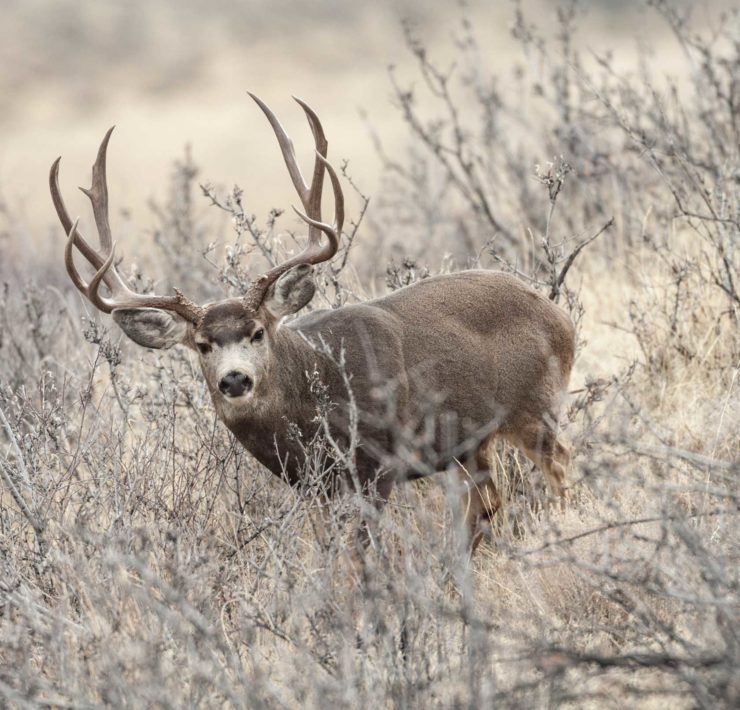Oregon State Spotlight
The Mule Deer Foundation is the only conservation group in…
Oregon’s banquet season is underway with the Klamath Chapter first in line. Their banquet was February 21st and again sold out with 395 adults and 45 youth. I must give a huge thank you to Brian Hayes and his committee for the excellent job they did while I was in Salt Lake City at our national convention. Next in line was the Linn-Benton Black-Tail Chapter in Albany. Their banquet was March 7th at the Lebanon Elks Lodge. When Chapter Chair Alan Bakkala, Co-Chair Mark Scoltock and their committee started three years ago I heard, “You’re not going to believe what we have planned!” They were right, I didn’t. Each year they have decorated the inside of the venue with movie set buildings from the Old West, which changes the atmosphere when you walk through the door. This year the chapter had a Statewide Mule Deer tag to auction from the Access and Habitat program which sold for $32,500 to a gentleman in the audience with four other bidders on the phone.
Mule Deer Initiative: Five-Year Check-In
In 2009, the Oregon Department of Fish and Wildlife (ODFW) made the commitment to try and do something about the state’s declining mule deer populations. It’s a problem across the West, blamed on many factors: habitat, predation, changing weather patterns, disturbance from ATV’s and poaching.
Following a series of public meetings, ODFW Director Roy Elicker launched the Oregon Mule Deer Initiative (MDI). Rather than attempting to address the problems in all 46 Wildlife Management Units (WMU) with mule deer, the Department selected five units to start the MDI effort—Heppner, Murderers Creek, Maury, Steens Mountain and Warner.
Local implementation teams made up of local sportsmen, private landowners and natural resource agency personnel were appointed to develop a plan for each unit. After five years of implementing these plans, the intent was to take what was learned in the MDI units and apply the successful actions to additional mule deer units. The cooperation continued once work began.
“The most amazing thing about MDI was the cooperation we got. Federal land agencies, county governments, private landowners, sportsman organizations like the Mule Deer Foundation – everyone got on board,” said Craig Foster, district wildlife biologist in Lake County for the Warner Unit. “The very fact that ODFW made mule deer a priority got a whole bunch of people involved. We leveraged that to do good things for deer.”
Habitat work: Within MDI units, more than 266,000 acres of habitat were treated at a cost of more than $18 million (87 percent of those funds came from cooperators, including from work benefiting sage grouse – see the table for more information). Natural resource agencies like USDA National Resources Conservation Service, U.S. Forest Service and the Bureau of Land Management were large contributors to habitat work, improving more than 195,000 acres and contributing more than $12.7 million for sagebrush habitat work.
Predator control: ODFW saw elk calf survival recruitment rates roughly double after cougar target efforts in Heppner and Ukiah, and hoped to repeat this success for mule deer in Warner and Steens Mountain. ODFW removed 28 cougars in Warner and 60 in Steens. This did not meet original targets (56 for Warner, 80 for Steens) as cougars became more difficult to catch as their populations declined. Mild weather also added to the challenge. While ODFW did not detect an increase in overall mule deer numbers in Warner and Steens, hunter success rates climbed, more mature bucks were taken and post-season buck ratios improved.
Regulation, TMAs, enforcement, disease: MDI efforts included increased Oregon State Police enforcement in all MDI units; seasonal closures of the Philip W. Schneider Wildlife Area to reduce disturbance to wintering mule deer in Murderers Creek; reduced tags in Warner and Maury; controlled archery seasons in Warner, Maury and Steens.
New survey method: When the MDI effort was started, ODFW recognized that its traditional “trend” population surveys, which looked at the same route each winter, were not accurate enough to measure a change in deer populations. As part of MDI efforts, the department implemented a more rigorous, statistics-based method called quadrat sampling. The method involves flying all deer winter range in a unit and then sub-sampling several randomly chosen one-square mile areas. Like any survey method, quadrat sampling depends on a winter concentration of deer for accurate measurements. But mild weather in 2012 and 2013 left deer scattered. “We were finding deer at 7,000 feet in the dead of winter while sampling,” says Foster. ODFW is now working to meld the best of traditional and quadrat surveys to try and reduce count sensitivity to weather conditions.
Results at five-year mark: The MDI process was very successful at identifying the problems affecting deer in specific areas and implementing an effort to address those problems. Some of the actions worked on the first try and some will need modifications. Wildlife managers were not expecting huge changes after just five years and the new survey methods were not conclusive in showing an increase in deer numbers. “We expect it will take time for deer to respond to habitat changes,” says Foster. “But in some MDI units, locals are telling us they are seeing more deer.”
Next steps:
Improving mule deer populations will be a long-term effort. “It took a long time to get to this spot and it will take a long time to turn the ship,” says Ronald Anglin, ODFW wildlife division administrator. “There is no silver bullet. It’s going to take a lot of work and a lot of investment over time.”
Anglin says continued MDI work depends on ODFW’s budget being approved, which includes a fee increase for hunting licenses and tags. “ODFW is depending on the fee increase to be able to maintain programs and to expand the MDI effort into additional units in eastern Oregon,” he said.
To see the entire report, visit www.odfw.com and see the Hunting Resources section or visit http://dfw.state.or.us/resources/hunting/big_game/mule_deer/MDI.asp
Bryant Mountain Winter Range Restoration project as submitted by Steve Hayner, Bureau of Land Management
Mule Deer Foundation Oregon chapters are helping to fund a habitat restoration project on Bryant Mountain, southwest of Klamath Falls. The area provides a mix of winter and summer range for mule deer, however due to the encroachment of western juniper, the sagebrush, bitterbrush and mountain mahogany have declined significantly and grasses have been reduced as well. This ultimately reduces the available foraging habitat for the Klamath mule deer herd.
The main objective of this project is to decrease the amount of western juniper and restore the understory by planting and seeding native shrubs and grasses. Approximately 1,950 acres have been identified within the project area to decrease the amount of juniper through a mix of hand cutting (chainsaw), mechanical cutting (mechanical shear) and piling of juniper. The piled juniper on most of the acres will be burned the following year and those burn pile areas will be planted with bitterbrush and mahogany seedlings. In areas the juniper is utilized for biomass or firewood, the area will be seeded with mountain big sagebrush, bitterbrush and native grasses.
This is a five-year $300,000 project and MDF has donated $10,000 to sow, plant and tube approximately 15,000 antelope bitterbrush and curleaf mountain mahogany seedlings within juniper removal areas.
Murderers Creek Fire Rehabilitation and Oliver Creek Pasture Restoration project submitted by Dan Marvin, ODFW biologist
MDF Oregon chapters are also helping to fund habitat restoration of the Phillip W. Schneider Wildlife Management Area in Eastern Oregon. This area provides secure winter range for mule deer from several wildlife management units, including Murderers Creek, Desolation, Silvies, East Beulah and Malheur River. These units have been the focus for considerable restoration efforts through the Mule Deer Initiative to improve conditions for wintering mule deer. In recent years, invasive annual grasses have become more established in the region out-competing more desirable native plant species and providing poor forage for mule deer and other wildlife species.
On August 1st 2014, a series of lightning strikes started the South Fork Complex wildfire on the Phillip W. Schneider Wildlife Area that eventually burned over 66,000 acres of State, BLM, Forest Service and Private lands. It is well documented that following fire, invasive annual grass species gain the competitive advantage on native plant species and soon dominate the site and landscape. With support from MDF, ODFW will treat 6,500 acres of the Phillip W. Schneider Wildlife Area with the herbicide Imazapic to reduce invasive grass competition and improve native rangeland vegetation through reseeding and shrub planting projects. This will help reestablish quality native forage for mule deer and other wildlife in this important winter range habitat.
In addition to reseeding the burn, ODFW will be restoring important pasture habitat in the Oliver Creek drainage on the Phillip W. Schneider Wildlife Area. It has been more than 20 years since these pastures have been planted and current vegetation vigor, diversity and production have declined in recent years. ODFW will be reseeding approximately 30 acres of pasture with a grass and forb mix to revitalize this critical habitat for mule deer and other wildlife use. MDF funds will be used to purchase the desired grass seed mixture to restore pasture conditions for improved mule deer forage.
P.L.A.Y. Outdoors (Promoting Lifelong Activities for Youth)
P.L.A.Y. Outdoors was created in 2010 by a coalition of local groups in Klamath Falls with interest in the outdoors. Each year on the third Saturday in January, the P.L.A.Y. sponsors host an event to engage youth in the outdoors and encourage them to step away from electronic devices and other unhealthy activities while promoting family oriented hobbies. The sponsoring organizations provide interactive activities including outdoor safety and survival, shooting sports education, fishing, camping skills, waterfowl calling instruction, caving, wildlife identification, build-a-birdhouse, and many more. Partners also set up informational booths about hunting and fishing and outdoor recreation while promoting safety and responsibility. While each group has its own goals and objectives we put them aside to focus on our youth. MDF’s Klamath Chapter is a sponsor of this event and committee member Allen Ferreira is one of the lead organizers.
The first P.L.A.Y. event was held in January 2011 with over 820 youth and 890 adults passing through the door to visit the 30-plus activities. The past three years there have been 1,250 youth and 1,100 adult attendees. More than 200 volunteers make the event possible with representatives from various local groups including: Mule Deer Foundation, Oregon Department of Fish & Wildlife, Oregon Hunters Association, U.S. Forest Service, Rocky Mountain Elk Foundation, Klamath County Mounted Horse Posse, Ducks Unlimited, Unlimited Pheasants, Lava Beds National Monument, 4-H, Home Depot, Boy Scouts and others. This year two new groups joined: Talk About Trees and the Klamath Basin Bee Keepers.
This year’s event, on January 17, 2015, broke our attendance record with 1,860 youth and 1,920 adults coming through the doors during a 6-hour period. New this year, ODFW brought two 14 ft. x 14 ft. portable tanks for their fishing event. The two tanks were filled with 2,750 gallons of spring water and 175 trophy rainbow trout. These tanks were purchased in 2014 by ODFW in Klamath with a grant from ODFW’s Restoration and Enhancement Program ($3,500) and $1,000 from P.L.A.Y. In another addition, youth attendees colored an “iron-on” picture that is pressed on a t-shirt – the iron-on pictures were provided by ODFW, the t-shirts by P.L.A.Y and the pressing was done by Rockin’ H Creations. The Home Depot once again furnished birdhouse kits and their employees and volunteers from Oregon Hunters and Henley’s JROTC helped youngsters build over 600 birdhouses.
The Mule Deer Foundation is the only conservation group in North America dedicated to restoring, improving and protecting mule deer and black-tailed deer and their habitat, with a focus on science and program efficiency. MDF is a strong voice for hunters in access, wildlife management and conservation policy issues. MDF acknowledges regulated hunting as a viable management component and is committed to recruitment and retention of youth into the shooting sports and conservation. Get involved in your state or become a member at www.muledeer.org or call 1-888-375-3337.



